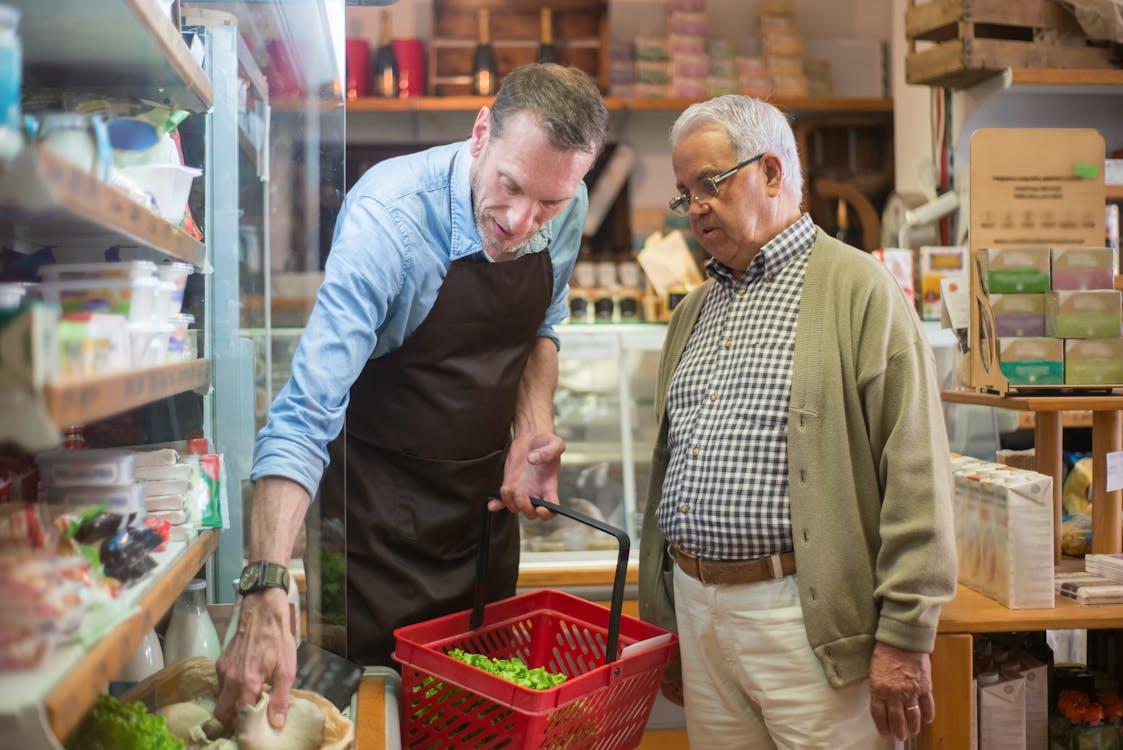
Australians are rethinking the rules of grocery shopping, and what was once considered polite behaviour is now frowned upon.
Rising costs and new supermarket technology have made everyday habits feel risky, even when the intention is simply to avoid paying for poor-quality produce.
The rise of grocery prices has forced households to adapt, with the average Australian family of four spending $240 per week—$12,480 per year—on groceries.
Seniors on fixed incomes feel this pinch acutely, making the temptation to bend the rules more understandable.
Yet, the social standards around shopping are tightening.
A recent survey revealed that 43 per cent of Australians changed how they shop following last year’s ACCC inquiry into supermarket pricing.
Twenty-three per cent said they were now much more cautious at major supermarkets, while 17 per cent shopped there less frequently.
Heightened awareness of pricing and ethics has made some previously normal habits unacceptable.
'Australians shouldn't settle for anything less than what they truly believe is great value when it comes to their weekly shop.'
Scanning cheaper versions of produce
Trying to pass off expensive mangoes as cheaper tomatoes has become almost impossible, with 60 per cent of Australians now considering it unacceptable.
Self-checkouts now use advanced scanning systems and individual barcodes to identify produce, making old tricks ineffective.
While technology has made fraud harder, this behaviour was always theft, even when self-checkouts were new.
Sampling produce before purchase
Tasting grapes or checking berries for sweetness used to be standard shopping sense, but 57 per cent now consider it unacceptable.
The pandemic accelerated this change, and supermarkets are now protecting their fresh produce investments.
Shoppers may feel frustrated paying premium prices for fruit that isn’t up to standard, yet the rules are clear—sampling is discouraged.
Removing inedible portions before weighing
Only 42 per cent of Australians found this unacceptable, so many still considered it reasonable.
Snapping broccoli stalks or removing corn husks before weighing made sense when paying by weight.
Some supermarkets discouraged this practice with signage, while others resolved it by pricing items individually, eliminating the incentive for modification.
Grocery spending by generation
Millennials spent around $56 per week on fruits and vegetables, while Boomers spent $38 per week.
Younger Australians tended to buy organic or premium produce, while older shoppers were more price-conscious and strategic.
How supermarkets responded
Retailers intensified technology to counter rule-bending, with some Australians still admitting to occasional cheating at self-checkouts.
Modern systems included visual recognition technology, weight sensors, overhead cameras, and algorithms flagging unusual purchasing patterns.
These measures increased the risk of dishonest practices, with legal consequences extending beyond the cost of a few mangoes.
The real cost of groceries
Australian households now spent an average of $178 per week on groceries.
Thirty-nine per cent of shoppers reported financial stress from grocery bills, up from 29 per cent three years ago.
Prices rose in 27 of 30 product categories, with fruit up 9.5 per cent, eggs 9 per cent, and vegetables 8 per cent.
Did you know?
ALDI sources 97 per cent of its fruits and vegetables from Australian farms Earning five-star ratings for both value for money and freshness.
Smart shopping strategies
Shoppers increasingly sought legitimate ways to reduce costs.
In 2025, 71 per cent monitored specials, up from 63 per cent in 2024.
Sixty-one per cent shopped around to find better deals.
Legitimate ways to reduce your grocery bill
- Shop specials and compare prices across multiple supermarkets
- Consider supermarket-owned brands rather than premium labels
- Choose frozen vegetables when fresh prices are too high
- Buy imperfect or 'ugly' produce when available at discount
- Take advantage of rewards programs like Woolworths Everyday Rewards
- Purchase in bulk when items are heavily discounted
What shoppers really wanted
Sixty-three per cent of Australians prioritised low prices across all products over convenience, variety, or rewards.
Only 10 per cent valued loyalty points or offers most, suggesting consistent value outweighed flashy promotions.
The changing landscape
Australians adapted by opting for frozen or bulk items, showing creativity in maintaining budgets.
Rising grocery costs made bending the rules tempting, yet improved technology and social expectations made shortcuts riskier and less acceptable.
Seniors navigating these changes benefited from ethical, strategic shopping to maintain fairness and community respect.
What This Means For You
Australians’ grocery habits have changed significantly due to rising costs and stricter social norms.
Practices like sampling produce or scanning cheaper items are now widely considered unacceptable, while technology at self-checkouts has made dishonest behaviour far more difficult.
At the same time, shoppers are discovering smart, ethical strategies that help them save money without breaking any rules.
For the audience, this means adapting to new expectations while still getting the best value for your weekly shop, proving that being savvy and respectful can go hand in hand.
If you found these grocery shopping tips useful, there’s a related story that explores how one major supermarket is changing the way people shop.
The piece highlights new features designed to make shopping more efficient and cost-conscious, offering real-life examples of how technology can improve the weekly shop.
It’s a practical follow-up for anyone looking to get the most out of their trips and navigate changing store practices.
Read more: ALDI reveals new features changing shopping habits: 'We're incredibly excited'
Best-Rated Supermarket Brand 2025 | Canstar Blue — Reports that the average weekly grocery bill for a household of four has climbed to $240, a $24 increase from the previous year.
https://www.canstarblue.com.au/stores-services/supermarkets/
Average grocery shop tops $12,000 per year despite shoppers changing habits — Highlights that the average household grocery shop has reached $12,480 per year, with significant increases in 2025.
https://www.bunburymail.com.au/stor...and-low-prices-over-rewards-new-survey-finds/
ACCC inquiry leads to change in Aussie shopping habits | Canstar Blue — Shows that 43 per cent of Australians changed how they shop following the ACCC inquiry into supermarket pricing.
https://www.canstarblue.com.au/stor...ry-changed-aussie-shopping-habits-march-2025/
ACCC inquiry leads to change in Aussie shopping habits | Canstar Blue — Reveals that 23 per cent of Australians became more cautious when shopping at major supermarkets, while 17 per cent shopped there less frequently.
https://www.canstarblue.com.au/stor...ry-changed-aussie-shopping-habits-march-2025/
Average Grocery Bill | Australian Living Costs – Canstar Blue — Notes that millennials spend approximately $56 per week on fruits and vegetables, while boomers spend $38, reflecting generational differences in shopping habits.
https://www.canstarblue.com.au/groceries/average-grocery-bill/
Even with new security measures like camera technology and weighted bays, a small number of Australians admit to cheating the system at self-service checkouts — Highlights ongoing attempts to bypass self-checkout rules despite technology improvements.
https://www.canstarblue.com.au/stores-services/supermarkets/
Average Grocery Bill | Australian Living Costs – Canstar Blue — Reports that households spend an average of $178 per week on groceries, with 61 per cent shopping across multiple supermarkets to reduce costs.
https://www.canstarblue.com.au/groceries/average-grocery-bill/
Best-Rated Supermarket Fruit & Veg 2025 | Canstar Blue — States that ALDI sources 97 per cent of its fruits and vegetables from Australian farms, achieving high customer satisfaction for freshness and value.
https://www.canstarblue.com.au/groceries/supermarket-fruit-veg/
Average grocery shop tops $12,000 per year despite shoppers changing habits — Shows that 71 per cent of shoppers monitor specials and compare stores, with a focus on strategic shopping to save money.
https://www.bunburymail.com.au/stor...and-low-prices-over-rewards-new-survey-finds/
Average grocery shop tops $12,000 per year despite shoppers changing habits — Highlights that 63 per cent of consumers prioritise low prices across all products, not just specials, over rewards programs.
https://www.bunburymail.com.au/stor...and-low-prices-over-rewards-new-survey-finds/
Have rising prices changed how you approach your weekly shop, and do you think these new standards are fair given the cost pressures families face?







